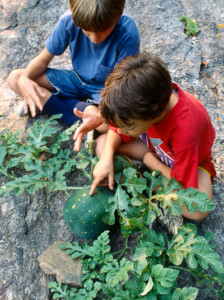Gardening With Kids: Opening Eyes and Doors

Two boys inspect ‘Moon and Stars’ watermelon in 7 year old boy’s garden
Our yards – gardens, landscaping and wild places – offer boundless opportunities for learning through all the senses. At a time when so many children – and adults too – suffer from “nature deficit disorder,” obesity, ADHD and other problems, connecting with nature is more important than ever. Typical suburban landscapes don’t supply the needs of either wildlife or children and can be downright toxic to both. In this talk I show – and get people to think about – easy ways to make the whole yard a safe place rich with sensory stimulation, opportunities for imaginative play and discovery. This includes:
- What kids really want
- Fostering creativity
- Plants that engage all the senses, support wildlife, tickle the funnybone
- How gardens open the door to learning about history, science, other cultures, the ancient earth, physics, stewardship
- The importance of bugs, fungus, water, dirt and things that stink
I was so pleased to discover, when speaking at The National Children & Youth Gardening Symposium a few years ago, that, while I had been fighting the tide of popular culture and figuring these things out with my son in our yard, teachers, landscape designers and botanical gardens had started a whole children’s gardening movement. I hope that adding my voice to theirs brings the message to your back – or even front – yard.
Reflections on my personal journey
Four big realizations upon becoming a mother made gardening a platform for learning for both me and my son:
- How profoundly growing up in woods and garden shaped and educated me, benefits I wanted to pass on.
- How every single thing a parent does teaches something.
- An aphorism that floored me with its truth: “A child is not a vessel to fill but a fire to light.”
- Seeing my son learn about the world with his entire body, all senses engaged, from the day of his birth
I began to plant experiences, not just plants and to give him a rich, safe environment to explore. Even the lawn was organic, so kids could roll on it and eat violets. We made places to dig and places to hide and dream; we named plants, insects, snakes, birds; we studied them, learning what they ate and where they lived; we planted vegetables with funny colors and plants for caterpillars and birds to eat; we preserved habitat by leaving stumps and native understory shrubs, carrying what we learned at home to all we encountered elsewhere. And so we began a journey of discovery that shapes how I landscape even now that he is an adult, what I teach as a garden coach (I’m very lucky to have some ongoing coaching clients with kids) and how we both experience the world.
Contact Karen to book this talk
Karen has also adapted this talk as part of a custom workshop. It’s really fun to speak first to adults then take kids on a walk through a garden.